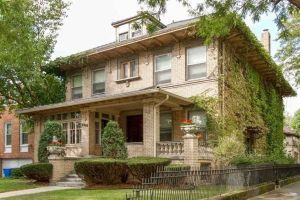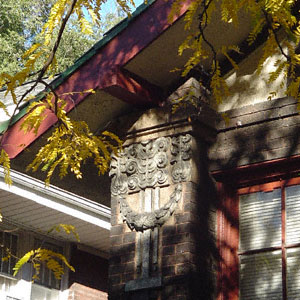Length of Walk: 1.25 miles (about 1 hour)
Where it is located: This walk is in the South Shore Community Area of Chicago. It is Walk #6 on the Walk Locations Map

How we got there: We drove and parked in the Jackson Park Highlands where there is plenty of street parking. If you drive, try parking on S. Cregier Ave., where the walk begins. You can review your public transportation options at: CTA Trip Planner
This walk is delightful for a late summer afternoon. Walk through the peaceful historic district of Jackson Park Highlands taking in every residential style imaginable from the early 20th century. End your day by driving over to the South Shore Cultural Center and walking through the grand restoration of this former country club, now owned and operated by the Chicago Park District. If the Parrot Cage Restaurant is open, you may be lucky enough to get a table outside with expansive views of Lake Michigan.
Ed’s Comments:
 Just imagine that you have 80 acres of undeveloped land just south of the White City at the 1893 Columbian Exposition and decide to develop it for the elite. The result is the Jackson Park Highlands neighborhood. Today these few blocks are an oasis of stately well kept homes nestled into a changing and challenging neighborhood. You won’t believe this secret has been so well kept.
Just imagine that you have 80 acres of undeveloped land just south of the White City at the 1893 Columbian Exposition and decide to develop it for the elite. The result is the Jackson Park Highlands neighborhood. Today these few blocks are an oasis of stately well kept homes nestled into a changing and challenging neighborhood. You won’t believe this secret has been so well kept.
Printable PDF of the Walk: Chicago Neighborhood Walk South Shore
The Walk:
South Shore Walk
The first to populate South Shore were German truck farmers who raised vegetables on small farms for sale in what was then the distant city. When the area was annexed to the city in 1889, city services extended into South Shore, spurring residential development. The opening of the University of Chicago and the World’s Columbian Exposition in Jackson Park in the 1890s also had a huge impact on the entire South Side Lakefront. The 1890s and early 1900s saw South Shore’s evolution into a full-fledged middle and upper middle class neighborhood. The 1906 founding of the South Shore Country Club established a popular social anchor for the area and contributed additional cachet to the South Shore community.
The Jackson Park Highlands came into being on August 3, 1905 as an eighty acre subdivision whose initial development was spearheaded by Chicago alderman, lawyer and real estate entrepreneur, Frank Bennett. The majority of houses, built between 1905 and 1940, reflect the rich and diverse forms and fashions of American residential architecture for 20th century single-family homes before WWII.
The Jackson Park Highlands is notable for its well preserved residential architecture for a formative time in American Residential Architecture. At the turn of the century, architects tended to follow one of two courses, either reviving styles of the past or working in styles that were innovative and progressive. Revivalist architecture reached its height of architectural excellence during the first 29 years of the 20th century, when Beaux Arts schooling provided traditionally trained architects of great skill, and the stock market had not yet eliminated most of their clients.
As you walk up and down the streets, you will see New England, Southern, Spanish and Dutch Colonial, English Tudor, Cotswold Cottage, French Provincial, Mediterranean Villa, Foursquare, and newcomers like Prairie and International styles. Many have matching two story “auto sheds” down their driveways. (From the Preliminary Staff Summary on the Jackson Park Highlands District submitted to the Commission on Chicago Landmarks, October 1988)
Do a quick drive by (red dotted line) of these two notable sites before starting the walking tour of the Jackson Park Highlands (where blue dotted line starts).
1. 7121 S. Paxton Av., Allan Miller House
1915 John Van Bergen, Architect
This house is notable as it is the only known work of Van Bergen left in Chicago. Van Bergen was a disciple of Frank Lloyd Wright and one of the most important contributors to the Prairie School of Architecture. Also notable in this house is the remarkable state of preservation. Probably no other Prairie School house in Chicago remains in as pristine condition as the Allan Miller house.
2. 2132 East 72nd Street, St. Philip Neri Church
1928 Joseph W. McCarthy, Architect
The church is a testament to the rapid growth of the South Shore neighborhood in the early years of the 20th century, when a dramatic growth in the population of German and Irish Catholics caused a rush of speculative building. Though the church may today appear decidedly traditional, at the time of its construction it was thought to be a great adaptation to its location and function and its style became known as “South Shore Gothic, 1928.”
Drive the route of the red dotted line and park your car near stop # 3 on S. Cregier where the blue line denotes the start of the walk. The numbered stops 3 – 8 are some notable homes in the Jackson Park Highlands. I just picked a couple from the Chicago Landmark Designation Report . You may want to research others from this report to add to your walk.
3. 6909 S. Cregier Ave., Cotswald Cottage
Phillip Maher, Architect
Phillip Maher incorporated the details of a picturesque English rural house type, the Cotswald Cottage, which is identified by its steeply sloping roof make of simulated thatch.
4. 6734 S. Bennett Avenue, Distinctive and featured on the 1922 cover of the Chicago Architectural Exhibition catalogue.
1917 Zimmerman, Saxe and Zimmerman, architects
While most houses were either traditionally academic or progressively modern, this house is an adroit amalgamation of stylistic references from both major trends. The long, low lines of this one story house, which mimic the flat horizontal lines of the Midwestern Landscape, are directly derivative from the Prairie school pioneered by Frank Lloyd Wright. The horizontal rows of windows, the massive masonry porch supports and the flattened pedestal urns are also Prairie style trademarks. From the California Craftsman style of Greene and Greene, which like the Prairie style was inspired by the Orient, come the multiple roof planes and peaked roof line of the two front gables. Turning to the past, the architects employ false Tudor half-timbering for a decorative effect, and a Renaissance classical balustrade bands the front terrace.
5. 6826 S. Euclid Ave, one of the first homes in the Highlands
1905 Greek Revival
This style has had a lasting attraction to Americans since the early days of the republic when it was promulgated in particular by Thomas Jefferson. With their democratic ideals and institutions, Americans felt themselves natural heirs to ancient Greek and Roman traditions as well as their architectural forms. The classic Greek Temple front is seen on court houses, capitol buildings as well as middle class houses.
6. 6801 S. Bennett Ave., Beaux-Arts Classicism
Phillip Maher, Architect
The style takes its name from the Ecole des Beaux-Arts in Paris, where some of America’s most prominent architects had studied. Its grandiose use of classical forms was employed to great popular success at the World’s Columbian Exposition in Chicago in 1893 and became an ideal medium to express corporate wealth or civic pride.
7. 6841 S. Bennett Ave.
1915, Harlev & Aga (from AIA Guide to Chicago)
Among the unusual features of this eclectic house are brickwork that imitates half-timbering and terra-cotta plaques (more commonly found on commercial buildings) stuck like postage stamps on the piers.
8. 6956 S. Bennett Ave., archetype of the International Style
1926, Paul Schweikher, Architect
Of all the early twentieth-century styles – Prairie, Craftsman, Art Deco – that deliberately rejected past history and sought to be timely and modern, the most radically iconoclastic was the International Style of the 1930s. Many of the world-class architects of European origin who also worked in the United States, among them Walter Gropius, Ludwig Mies van der Rohe, and Marcel Breuer, initiated their practices working in the International Style, generally characterized by a stark simplicity devoid of applied ornamentation. Ribbon windows were an important trait of this style as were corner windows in which the glass was mitered without any corner support. Other design features were flat roof tops and smooth, uniform wall surfaces.
Return to your car on S. Cregier Ave. and head over to the South Shore Cultural Center.
9. South Shore Cultural Center, 7059 S. South Shore Dr.
1906, 1919, 1916, Marshall and Fox, Architects
The South Shore Cultural Center was originally designed as a private club, the South Shore Country Club, by the architectural firm of Marshall and Fox. The architects renowned for their hotel and apartment building designs throughout the Chicagoland area, Marshall and Fox are best known for their design of the Drake and Blackstone Hotels. They constructed the original South Shore Club House in 1906 in the Italian Resort Style, resembling a summer palace. Of the original structure, the only remaining portion is the ballroom (now Paul Robeson Theatre) on the south end of the existing building. In 1916, after expansion in membership and social importance in Chicago, the old clubhouse was moved to the south section of the grounds and became the golf club house (no longer in existence). Marshall and Fox were hired again to design a new clubhouse.
For decades, the South Shore Country Club was a playground for Chicago’s rich. In the 1960’s, the club was abandoned and fell into disrepair. Over the next few years, community activists pushed to have the club restored and in 1974, the Chicago Park District purchased the club for $10 million. The site became listed on the National Register of Historic Places in 1975. In 1984, the Chicago Park District rehabilitated the club house using interior color schemes developed by the original architects, Marshall and Fox.
Today, the South Shore Cultural Center is one of the Chicago Park District’s most significant historical sites. The center sits on 58 acres of land and is a common space for weddings, banquets and cultural activities. President Barack Obama and First Lady Michelle Obama had their wedding reception here.
(From Hyde Park-Kenwood Community Conference Parks Committee)
The Parrot Cage Restaurant, run by the Washburne Culinary Institute, also is housed here.
If you are a member of Map My Walk, here is the link to send the map to your phone: South Shore Jackson Park Highlands Walk
Additional Resources: South Shore History , Landmark Designation Report Jackson Park Highlands, Landmark Designation Report South Shore Cultural Center, Landmark Designation Report Allan Miller House

